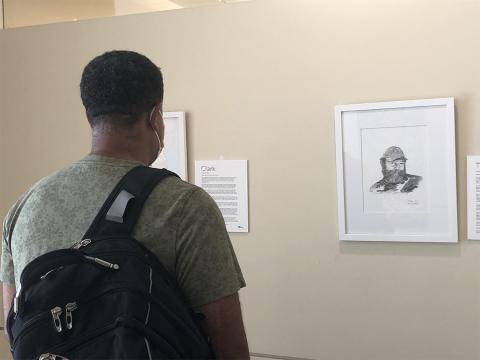INTO LIGHT
Exhibit Portrays the Human Side of the Overdose Crisis

Photo: Dana Talesnik
Addiction does not discriminate. It can afflict anyone from any background, and yet there remains a stigma surrounding people who struggle with addiction. One artist is working to erase that stigma—inspired by personal experience—through a nationwide art project.
A collection of eight charcoal portraits, now on display at the Clinical Center, depicts people who have died of a drug overdose. They were drawn by Theresa Clower, whose son Devin was 32 years old when he died of an opioid overdose in 2018.

The exhibit, in collaboration with NIDA, hangs in the east alcove just off the Clinical Center atrium, fittingly near a corridor that leads to the labs of another institute that studies addiction, NIAAA. The portraits at NIH—which will remain on display until Jan. 8, 2023—are a small segment of the more than 300 portraits Clower has drawn so far, part of an ongoing project organized by INTO LIGHT, the nonprofit she founded.
Drawing Devin—Clower’s first-ever attempt at portraiture—helped her process her grief and inspired her to draw others who died in recent years from drug overdose. She used graphite as a medium to illuminate each face, each multifaceted person who struggled and succumbed, to symbolize that each person has light and dark moments.

“People with the disease of addiction are often blamed for their illness,” said Dr. Barbara Francois, a psychologist who is the narrative writer for INTO LIGHT. “Sharing the stories of the loved ones in this project helps us to know them and provides an opportunity to educate the public about substance use disorder, not as a moral weakness, but as a brain disorder that needs treatment.”

Their addiction was one part of a much larger story, told through narratives that pay tribute to the lives lost. Each of the portraits is expressive. Some pensive, others smiling.
Timothy was a brick mason for 35 years and a loving dad who got hooked on opiates prescribed for back pain. He ultimately died of a heroin overdose at age 54. Clark, who also became addicted to opioids following pain from a car accident injury, died at 30.
Sarah loved hiking and going to concerts. She struggled for many years with anxiety and succumbed to her addiction at age 35. Andrew was a devoted dad and massive sports fan who lost his addiction battle at age 31.
These are among the people featured to help change the conversation about addiction. While science can help address the crisis in many ways, it is only one part of the picture. Compassion and support are needed to encourage treatment and sustain recovery.

Last year, Clower reached out to NIDA director Dr. Nora Volkow, who helped facilitate bringing the exhibit to the Clinical Center.
“Science and art are not often thought of together in tandem,” said Volkow, “but the intersection of neuroscience to understand how the brain changes due to substance use and addiction and art to remind us of our shared humanity provides a powerful way to help alleviate deep-rooted stigma and inaccurate perceptions.
“While scientific evidence can build a case with evidence and data, the emotional connection experienced through art can be an even stronger argument for changed perspectives on addiction and overdose.”
